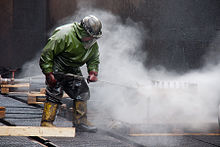high pressure cleaner
A high-pressure cleaner is a device that removes stubborn dirt with the help of 15 to over 1000 bar water pressure and, if necessary, with the addition of cleaning agents. The drive is usually electric or by means of a combustion engine . Alternatively, high-pressure cleaners with hydraulic motors or power take- offs (PTO) are also available.
Components
The high pressure cleaner usually consists of the following components:
- Drive motor
- high pressure pump
- Radiator (optional)
- Detergent tank
- Frame with chassis
- Protective hood
- High pressure hose
- Hand gun
- High pressure nozzle
functionality
The cleaning medium (water) is brought under high pressure by a piston pump and, in the case of heated high-pressure cleaners, is heated by means of an electric heating element or burners operated with fossil fuels (gas or heating oil). The high pressure generates a high-speed water jet at the cleaning nozzle or spray head. This enables surfaces to be freed of even the most stubborn dirt or paint layers. Since the water jet is very sharp, there is both an increased risk of accidents for bystanders and damage to the surface to be treated. For complex cleaning tasks, special cleaning agents are available that loosen stubborn dirt or B. disinfect in the food industry.
High-pressure cleaners of the lower class use water pressures of 80 to 100 bar, with flow rates in the range of approx. 400 l / h. The middle class is made up of devices from around 150 to 200 bar with flow rates of up to around 1,200 l / h. Professional devices have flow rates from approx. 1,500 l / h. High pressure cleaners with a water pressure of over 2000 bar are also known as high pressure cleaners. These devices are also used to process surfaces in the industrial sector. Cutting through metal or stone slabs with the help of water pressure ( water jet cutting ) also work at maximum pressure.
For an optimal cleaning effect, you need not only sufficient pressure but also a large amount of water, which ensures a high impact force and removes the loosened dirt (flushing power).
With a dirt grinder (or rotary nozzle), a rotating point jet nozzle, stubborn encrustations (metallic oxidation and packing) can be removed over a large area. It is particularly used for tank cleaning, but is not recommended for sensitive materials. Here you should only work with a flat jet nozzle from a safe distance.
Application examples:
- Street pavement cleaning in pedestrian areas - removal of chewing gum
- Facade cleaning
- Engine cleaning (after dismantling) of deposits
history
The first steam jet cleaner comes from the USA . When the devices were used by the US Army in the American Occupation Zone after the Second World War , they were serviced and repaired by Alfred Kärcher , the founder of the company of the same name , on behalf of the US Army. From these devices, Alfred Kärcher developed the first European high-pressure cleaner, the DS 350, in 1950. He improved the steam cleaning process that had been common up until then by adding a pump to the steam circuit and, due to the pressure created, was able to significantly improve the cleaning power of the devices. Nowadays, his (brand) name or the neologism Kärchern is often used colloquially as a generic name for high-pressure cleaners in general.
safety
For high-pressure cleaners used commercially in Germany, a safety check is required in accordance with the deadlines in BGV -A3 Table 1B: Repetitive tests of portable electrical equipment in conjunction with the VDE regulations.
The original accident prevention regulation BGV D15 (VBG 87) “BG regulation: Working with liquid ejectors ” was withdrawn when the Industrial Safety Ordinance came into force and is included in BGR 500, Chapter 2.36. The original BGV D15, however, still applies to work equipment that was made available to employees for the first time before October 3, 2002 and that are not subject to the application of EC directives that have been implemented in German law. The wearing of protective goggles or suitable protective clothing for commercial use is a prerequisite for proper operation.
The BGHW leaflet M13 provides a clear summary of the current rules and also shows that a minimum age of 16 years is required to operate high-pressure cleaners.
Well-known manufacturers
- Hammelmann machine factory
- Kärcher
- Nilfisk-Alto (formerly WAP)
See also
Web links
Individual evidence
- ↑ BGV D15. (PDF; 216 kB) Accident prevention regulations, work with liquid jets. Trade Association for Precision Mechanics and Electrical Engineering, accessed on May 21, 2012 .
- ↑ BGR 500. Operation of work equipment. Umwelt-online, accessed on May 21, 2012 .
- ↑ Leaflet M13. (PDF; 340 kB) High-pressure cleaner. Berufsgenossenschaft Handel und Warendistribution (BGHW), accessed on May 21, 2012 .


